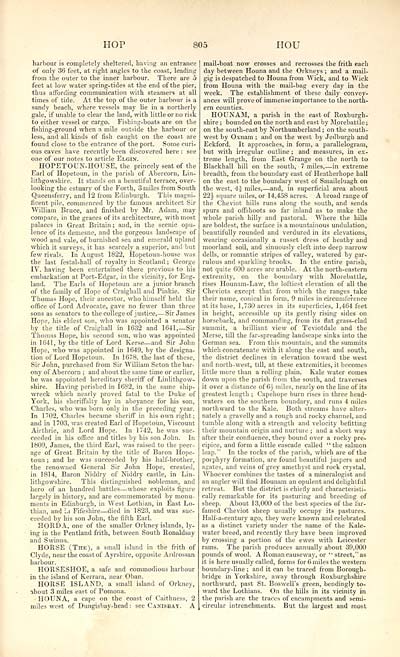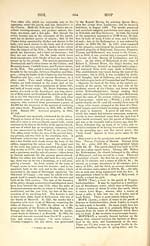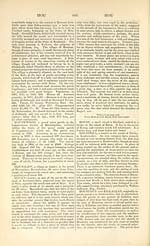Topographical, statistical, and historical gazetteer of Scotland > Volume 1
(905) Page 805
Download files
Complete book:
Individual page:
Thumbnail gallery: Grid view | List view

HOP
805
II ou
harbour is completely sheltered, having an entrance
of only 36 feet, at right angles to the coast, leading
from the outer to the inner harbour. There are 5
feet at low water spring-tides at the end of the pier,
thus affording communication with steamers at all
times of tide. At the top of the outer harbour is a
sandy beach, where vessels may lie in a northerly
gale, if unable to clear the land, with little or no risk
to either vessel or cargo. Fishing-boats are on the
fishing-ground when a mile outside the harbour or
less, and all kinds of fish caught on the coast are
found close to the entrance of the port. Some curi-
ous caves have recently been discovered here : see
one of our notes to article Elgin.
HOPETOUN-HOUSE, the princely seat of the
Earl of Hopetoun, in the parish of Abercorn, Lin-
lithgowshire. It stands on a beautiful terrace, over-
looking the estuary of the Forth, 3 miles from South
Queensferry, and 12 from Edinburgh. This magni-
ficent pile, commenced by the famous architect Sir
William Bruce, and finished by Mr. Adam, may
compare, in the graces of its architecture, with most
palaces in Great Britain ; and, in the scenic opu-
lence of its demesne, and the gorgeous landscape of
wood and vale, of burnished sea and emerald upland
which it surveys, it has scarcely a superior, and but
few rivals. In August 1822, Hopetoun-house was
the last festal-hall of royalty in Scotland ; George
IV. having been entertained there previous to his
embarkation at Port-Edgar, in the vicinity, for Eng-
land. The Earls of Hopetoun are a junior branch
of the family of Hope of Craighall and Pinkie. Sir
Thomas Hope, their ancestor, who himself held the
office of Lord Advocate, gave no fewer than three
sons as senators to the college of justice, — Sir James
Hope, his eldest son, who was appointed a senator
by the title of Craighall in 1632 and 1641,—Sir
Thomas Hope, his second son, who was appointed
in 1641, by the title of Lord Kerse — and Sir John
Hope, who was appointed in 1649, by the designa-
tion of Lord Hopetoun. In 1678, the last of these,
Sir John, purchased from Sir William Seton the bar.
ony of Abercorn ; and about the same time or earlier,
he was appointed hereditary sheriff of Linlithgow-
shire. Having perished in 1682, in the same ship-
wreck which nearly proved fatal to the Duke of
York, his sheriffalty lay in abeyance for his son,
Charles, who was born only in the preceding year.
In 1702, Charles became sheriff in his own right;
and in 1703, was created Earl of Hopetoun, Viscount
Airthrie, and Lord Hope. In 1742, he was suc-
ceeded in his office and titles by his son John. In
1809, James, the third Earl, was raised to the peer-
age of Great Britain by the title of Baron Hope-
toun ; and he was succeeded by his half-brother,
the renowned General Sir John Hope, created,
in 1814, Baron Niddry of Niddry castle, in Lin-
lithgowshire. This distinguished nobleman, and
hero of an hundred battles — whose exploits figure
largely in history, and are commemorated by monu-
ments in Edinburgh, in West Lothian, in East Lo-
thian, and :,i Fifeshire — died in 1823, and was suc-
ceeded by his son John, the fifth Earl.
HORDA, one of the smaller Orkney islands, ly-
ing in the Pentland frith, between South Ronaldsay
and Swinna.
HORSE (The), a small island in the frith of
Clyde, near the coast of Ayrshire, opposite Ardrossan
harbour.
HORSESHOE, a safe and commodious harbour
in the island of Kerrara, near Oban.
HORSE ISLAND, a small island of Orkney,
about 3 miles east of Pomona.
HOUNA, a cape on the coast of Caithness, 2
miles west of Dungisbay-head : see Canisbay. A
mail-boat now crosses and recrosses the frith each
day between Houna and the Orkneys ; and a mail-
gig is despatched to Houna from Wick, and to Wick
from Houna with the mail-bag every day in the
week. The establishment of these daily convey-
ances will prove of immense importance to the north-
ern counties.
HOUNAM, a parish in the east of Roxburgh-
shire ; bounded on the north and east by Morebattle ;
on the south-east by Northumberland ; on the south-
west by Oxnam ; and on the west by Jedburgh and
Eckford. It approaches, in form, a parallelogram,
but with irregular outline ; and measures, in ex-
treme length, from East Grange on the north to
Blackball hill on the south, 7 miles, — in extreme
breadth, from the boundary east of Heatherhope hall
on the east to the boundary west of Smaileluagh on
the west, 4J miles, — and, in superficial area about
22J square miles, or 14,458 acres. A broad range of
the Cheviot hills runs along the south, and sends
spurs and offshoots so far inland as to make the
whole parish hilly and pastoral. Where the hills
are boldest, the surface is a mountainous undulation,
beautifully rounded and verdured in its elevations,
wearing occasionally a russet dress of heathy and
moorland soil, and sinuously cleft into deep narrow
dells, or romantic stripes of valley, watered by gar-
rulous and sparkling brooks. In the entire parish,
not quite 600 acres are arable. At the north-eastern
extremity, on the boundary with Morebattle,
rises Hounam-Law, the loftiest elevation of all the
Cheviots except that from which the ranges take
their name, conical in form, 9 miles in circumference
at its base, 1,730 acres in its superficies, 1,464 feet
in height, accessible up its gently rising sides on
horseback, and commanding, from its flat grass-clad
summit, a brilliant view of Teviotdale and the
Merse, till the far-spreading landscape sinks into the
German sea. From this mountain, and the summits
which concatenate with it along the east and south,
the district declines in elevation toward the west
and north-west, till, at these extremities, it becomes
little more than a rolling plain. Kale water comes
down upon the parish from the south, and traverses
it over a distance of 6J- miles, nearly on the line of its
greatest length ; Capehope burn rises in three head-
waters on the southern boundary, and runs 4 miles
northward to the Kale. Both streams have alter-
nately a gravelly and a rough and rocky channel, and
tumble along with a strength and velocity befitting
their mountain origin and nurture ; and a short way
after their confluence, they bound over a rocky pre-
cipice, and form a little cascade called " the salmon
leap." In the rocks of the parish, which are of the
porphyry formation, are found beautiful jaspers and
agates, and veins of grey amethyst and rock crystal.
Whoever combines the tastes of a mineralogist and
an angler will find Hounam an opulent and delightful
retreat. But the district is chiefly and characteristi-
cally remarkable for its pasturing and breeding of
sheep. About 13,000 of the best species of the far-
famed Cheviot sheep usually occupy its pastures.
Half-a-century ago, they were known and celebrated
as a distinct variety under the name of the Kale-
water breed, and recently they have been improved
by crossing a portion of the ewes with Leicester
rams. The parish produces annually about 39,000
pounds of wool. A Roman causeway, or " street," as
it is here usually called, forms for 6 miles the western
boundary-line ; and it can be traced from Borough-
bridge in Yorkshire, away through Roxburghshire
northward, past St. Boswell's green, bendingly to-
ward the Lothians. On the hills in its vicinity in
the parish are the traces of encampments and semi-
circular intrenchments. But the largest and most
805
II ou
harbour is completely sheltered, having an entrance
of only 36 feet, at right angles to the coast, leading
from the outer to the inner harbour. There are 5
feet at low water spring-tides at the end of the pier,
thus affording communication with steamers at all
times of tide. At the top of the outer harbour is a
sandy beach, where vessels may lie in a northerly
gale, if unable to clear the land, with little or no risk
to either vessel or cargo. Fishing-boats are on the
fishing-ground when a mile outside the harbour or
less, and all kinds of fish caught on the coast are
found close to the entrance of the port. Some curi-
ous caves have recently been discovered here : see
one of our notes to article Elgin.
HOPETOUN-HOUSE, the princely seat of the
Earl of Hopetoun, in the parish of Abercorn, Lin-
lithgowshire. It stands on a beautiful terrace, over-
looking the estuary of the Forth, 3 miles from South
Queensferry, and 12 from Edinburgh. This magni-
ficent pile, commenced by the famous architect Sir
William Bruce, and finished by Mr. Adam, may
compare, in the graces of its architecture, with most
palaces in Great Britain ; and, in the scenic opu-
lence of its demesne, and the gorgeous landscape of
wood and vale, of burnished sea and emerald upland
which it surveys, it has scarcely a superior, and but
few rivals. In August 1822, Hopetoun-house was
the last festal-hall of royalty in Scotland ; George
IV. having been entertained there previous to his
embarkation at Port-Edgar, in the vicinity, for Eng-
land. The Earls of Hopetoun are a junior branch
of the family of Hope of Craighall and Pinkie. Sir
Thomas Hope, their ancestor, who himself held the
office of Lord Advocate, gave no fewer than three
sons as senators to the college of justice, — Sir James
Hope, his eldest son, who was appointed a senator
by the title of Craighall in 1632 and 1641,—Sir
Thomas Hope, his second son, who was appointed
in 1641, by the title of Lord Kerse — and Sir John
Hope, who was appointed in 1649, by the designa-
tion of Lord Hopetoun. In 1678, the last of these,
Sir John, purchased from Sir William Seton the bar.
ony of Abercorn ; and about the same time or earlier,
he was appointed hereditary sheriff of Linlithgow-
shire. Having perished in 1682, in the same ship-
wreck which nearly proved fatal to the Duke of
York, his sheriffalty lay in abeyance for his son,
Charles, who was born only in the preceding year.
In 1702, Charles became sheriff in his own right;
and in 1703, was created Earl of Hopetoun, Viscount
Airthrie, and Lord Hope. In 1742, he was suc-
ceeded in his office and titles by his son John. In
1809, James, the third Earl, was raised to the peer-
age of Great Britain by the title of Baron Hope-
toun ; and he was succeeded by his half-brother,
the renowned General Sir John Hope, created,
in 1814, Baron Niddry of Niddry castle, in Lin-
lithgowshire. This distinguished nobleman, and
hero of an hundred battles — whose exploits figure
largely in history, and are commemorated by monu-
ments in Edinburgh, in West Lothian, in East Lo-
thian, and :,i Fifeshire — died in 1823, and was suc-
ceeded by his son John, the fifth Earl.
HORDA, one of the smaller Orkney islands, ly-
ing in the Pentland frith, between South Ronaldsay
and Swinna.
HORSE (The), a small island in the frith of
Clyde, near the coast of Ayrshire, opposite Ardrossan
harbour.
HORSESHOE, a safe and commodious harbour
in the island of Kerrara, near Oban.
HORSE ISLAND, a small island of Orkney,
about 3 miles east of Pomona.
HOUNA, a cape on the coast of Caithness, 2
miles west of Dungisbay-head : see Canisbay. A
mail-boat now crosses and recrosses the frith each
day between Houna and the Orkneys ; and a mail-
gig is despatched to Houna from Wick, and to Wick
from Houna with the mail-bag every day in the
week. The establishment of these daily convey-
ances will prove of immense importance to the north-
ern counties.
HOUNAM, a parish in the east of Roxburgh-
shire ; bounded on the north and east by Morebattle ;
on the south-east by Northumberland ; on the south-
west by Oxnam ; and on the west by Jedburgh and
Eckford. It approaches, in form, a parallelogram,
but with irregular outline ; and measures, in ex-
treme length, from East Grange on the north to
Blackball hill on the south, 7 miles, — in extreme
breadth, from the boundary east of Heatherhope hall
on the east to the boundary west of Smaileluagh on
the west, 4J miles, — and, in superficial area about
22J square miles, or 14,458 acres. A broad range of
the Cheviot hills runs along the south, and sends
spurs and offshoots so far inland as to make the
whole parish hilly and pastoral. Where the hills
are boldest, the surface is a mountainous undulation,
beautifully rounded and verdured in its elevations,
wearing occasionally a russet dress of heathy and
moorland soil, and sinuously cleft into deep narrow
dells, or romantic stripes of valley, watered by gar-
rulous and sparkling brooks. In the entire parish,
not quite 600 acres are arable. At the north-eastern
extremity, on the boundary with Morebattle,
rises Hounam-Law, the loftiest elevation of all the
Cheviots except that from which the ranges take
their name, conical in form, 9 miles in circumference
at its base, 1,730 acres in its superficies, 1,464 feet
in height, accessible up its gently rising sides on
horseback, and commanding, from its flat grass-clad
summit, a brilliant view of Teviotdale and the
Merse, till the far-spreading landscape sinks into the
German sea. From this mountain, and the summits
which concatenate with it along the east and south,
the district declines in elevation toward the west
and north-west, till, at these extremities, it becomes
little more than a rolling plain. Kale water comes
down upon the parish from the south, and traverses
it over a distance of 6J- miles, nearly on the line of its
greatest length ; Capehope burn rises in three head-
waters on the southern boundary, and runs 4 miles
northward to the Kale. Both streams have alter-
nately a gravelly and a rough and rocky channel, and
tumble along with a strength and velocity befitting
their mountain origin and nurture ; and a short way
after their confluence, they bound over a rocky pre-
cipice, and form a little cascade called " the salmon
leap." In the rocks of the parish, which are of the
porphyry formation, are found beautiful jaspers and
agates, and veins of grey amethyst and rock crystal.
Whoever combines the tastes of a mineralogist and
an angler will find Hounam an opulent and delightful
retreat. But the district is chiefly and characteristi-
cally remarkable for its pasturing and breeding of
sheep. About 13,000 of the best species of the far-
famed Cheviot sheep usually occupy its pastures.
Half-a-century ago, they were known and celebrated
as a distinct variety under the name of the Kale-
water breed, and recently they have been improved
by crossing a portion of the ewes with Leicester
rams. The parish produces annually about 39,000
pounds of wool. A Roman causeway, or " street," as
it is here usually called, forms for 6 miles the western
boundary-line ; and it can be traced from Borough-
bridge in Yorkshire, away through Roxburghshire
northward, past St. Boswell's green, bendingly to-
ward the Lothians. On the hills in its vicinity in
the parish are the traces of encampments and semi-
circular intrenchments. But the largest and most
Set display mode to: Large image | Transcription
Images and transcriptions on this page, including medium image downloads, may be used under the Creative Commons Attribution 4.0 International Licence unless otherwise stated. ![]()
| Gazetteers of Scotland, 1803-1901 > Topographical, statistical, and historical gazetteer of Scotland > Volume 1 > (905) Page 805 |
|---|
| Permanent URL | https://digital.nls.uk/97448406 |
|---|
| Description | Volume first. A-H. |
|---|---|
| Attribution and copyright: |
|

